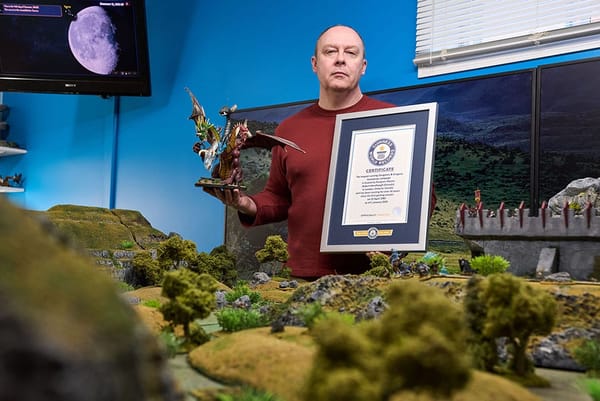The 30-year hunt for the Golden Owl treasure is finally over

From the BBC: "The world’s longest treasure hunt appears to have come to an end, after an announcement in France that a buried statuette of a golden owl has finally been unearthed - after 31 years. The message was posted by Michel Becker, who illustrated the original Chouette d’Or (golden owl) book and sculpted the buried statuette in 1993. No further information about the site or the finder was available and Mr Becker was not contactable by telephone. Tens of thousands of people have taken part in the search, which has spawned a huge secondary literature in books and Internet sites. They have all been following 11 complicated puzzles set out in the first book by its creator, Max Valentin. When he died in 2009, Mr Becker took over the operation. A documentary on the treasure hunt said earlier this year that the value of the owl is estimated to be €150,000."
Einstein invented a refrigerator with no moving parts that ran on butane

From Wikipedia: "From 1926 until 1934 Einstein and Szilárd collaborated on ways to improve home refrigeration technology. The two were motivated by contemporary newspaper reports of a Berlin family who had been killed when a seal in their refrigerator failed and leaked toxic fumes into their home. Einstein and Szilárd proposed that a device without moving parts would eliminate the potential for seal failure, and explored practical applications for different refrigeration cycles. Einstein had worked in the Swiss Patent Office, and used his experience to apply for valid patents for their inventions in several countries. The refrigerator was less efficient than existing appliances, although having no moving parts made it more reliable; the introduction of Freon made it even less attractive commercially and the Great Depression dried up funding."
A newly uncovered throne room in Peru may have belonged to an ancient queen

From The Smithsonian: "Archaeologists have discovered a richly decorated throne room on the northern coast of Peru that may have belonged to a female ruler of the Moche culture some 1,300 years ago. The room is located in Pañamarca, an archaeological site built and occupied by the Moche, an Indigenous civilization that flourished between roughly 350 and 850 C.E.—centuries before the better-known Inca built Machu Picchu to the southeast. Rediscovered by archaeologists in the 1950s, Pañamarca contains monumental adobe platforms, walls and temples, as well as elaborate, colorful murals. Peruvian and American researchers have been studying the ancient Moche site since 2018. During their most recent field session, they found an adobe throne room dating back to the seventh century that is painted scenes involving a “powerful woman.”
The fierce battle over one of the world's most valuable shipwrecks

From the BBC: "It has been hailed as the most valuable shipwreck in the world. A Spanish galleon, the San José, was sunk by the British off the coast of Colombia more than 300 years ago. It had a cargo of gold, silver and emeralds worth billions of dollars. But years after it was discovered, a debate still rages over who owns that treasure and what should be done with the wreck. The Colombian and Spanish states have staked a claim to it, as have a US salvage company and indigenous groups in South America. There have been court battles in Colombia and the US, and the case is now before the Permanent Court of Arbitration at the Hague. The Colombian government says it wants to raise the remains of the vessel and put it in a museum. Treasure hunters point to the commercial value of the cargo, which could be as much as $18bn."
A painting found by a junk dealer in a basement turns out to be an original Picasso

From The Guardian: "A painting that was found by a junk dealer while he was clearing out the cellar of a home in Capri, and was regularly decried by his wife as “horrible”, is an original portrait by Pablo Picasso, Italian experts have claimed. After he stumbled across the painting in 1962, Luigi Lo Rosso took the rolled-up canvas home with him to Pompeii, where it hung in a cheap frame on the living room wall for the next few decades. The portrait, which is now believed by its owners to be a distorted image of Dora Maar, a French photographer and painter who was Picasso’s mistress and muse, featured the famous artist’s distinctive signature in the top left-hand corner. But Lo Rosso didn’t know who he was. It was only much later, when his son Andrea started to ask questions after studying an encyclopedia of art history, that suspicions were aroused."
The anamorphic art of Thomas Deininger
The anamorphic art of Thomas Deininger pic.twitter.com/v3S0ciFCD0
— Interesting (@InterestingsAsF) October 4, 2024
Acknowledgements: I find a lot of these links myself, but I also get some from other newsletters that I rely on as "serendipity engines," such as The Morning News from Rosecrans Baldwin and Andrew Womack, Jodi Ettenberg's Curious About Everything, Dan Lewis's Now I Know, Robert Cottrell and Caroline Crampton's The Browser, Clive Thompson's Linkfest, Noah Brier and Colin Nagy's Why Is This Interesting, Maria Popova's The Marginalian, Sheehan Quirke AKA The Cultural Tutor, the Smithsonian magazine, and JSTOR Daily. If you come across something interesting that you think should be included here, please feel free to email me at mathew @ mathewingram dot com



